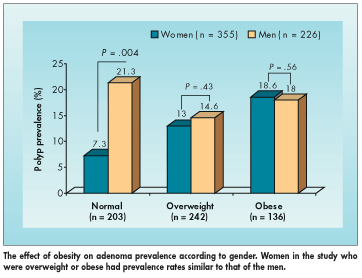African Americans with proximal polyps and overweight or obese women are at higher risk for colorectal cancer: Researchers call for more screening
Cancer in the proximal colon, the right part of the colon closest to the small intestine, has been increasing in African-American men since the mid-1990s.
WASHINGTONCancer in the proximal colon, the right part of the colon closest to the small intestine, has been increasing in African-American men since the mid-1990s.
The rising incidence stands in marked contrast to the overall decrease in colorectal cancer rates seen over the past 20 years, said Ananya Das, MD, associate professor, Division of Gastroenterology, at the Mayo Clinic in Scottsdale, Arizona. Dr. Das presented the findings at the Digestive Disease Week 2007 conference (abstract 431).
Dr. Das and his colleagues analyzed millions of records from the National Cancer Institute's Surveillance, Epidemiology, and End Results (SEER) database, calculating sex-, race-, and site-specific incidence for all patients with confirmed, invasive, primary colorectal cancer between 1973 and 2003.
Overall colorectal cancer rates declined during this period in both blacks and whites and in both men and women, the researchers found. But when they looked at proximal colon cancer among African Americans, they "came up with a very startling observation," Dr. Das commented. Starting in the mid-1990s, rates began rising for African Americans, especially men.
Although the reason for the increase is unknown, it does suggest that screening among African Americans should include complete colonoscopies, Dr. Das said. Colonoscopy, in contrast to sigmoidoscopy, includes the proximal section of the colon.
"There are very convincing data that African Americans have lower rates of colonoscopy screening, even after having colon cancer," Dr. Das said. "That could help explain the findings."

Obesity as a risk factor
Risk factors for colorectal cancer may also include obesity and overweight among women, according to another study presented at Digestive Disease Week (abstract 430).
Researchers at the New York University School of Medicine found that among 581 patients referred for screening colonoscopy, men were generally more likely to have polyps of any size.
However, women in the study who were overweight (defined as a body mass index of 25 to 29.9) or obese (defined as body mass index of 30 or higher) had rates similar to that of the men (see Figure below).
Among the overweight and obese women, the prevalence of polyps was 13%, compared with 14.6% for men, and the prevalence of advanced neoplasms was 18.6% for women, compared with 18% for men.
Women of normal weight (body mass index of 18 to 24) were significantly less likely to have polyps of any size.
"What this tells us is that we can use body mass index as a way to further risk stratify women and to encourage colorectal screening," said senior author Fritz Francois, MD, assistant professor, Division of gastroenterology, at New York University Medical School.
Not enough colonoscopies?
Dr. Das concurred. "We may not be doing enough colonoscopies," he said, when discussing his group's findings in African-American men. "We need to take a new look at the screening recommendations."